Rによるデータ前処理実習
(Graduate School of Life Sciences, Tohoku University)
前処理は大きく2つに分けられる
- データ構造を対象とする処理 (👈今回の主題)
- 使いたい部分だけ抽出
- グループごとに特徴を要約
- 大きい順に並べ替え
- 異なるテーブルの結合
- 変形: 縦長 ↔ 横広
- データ内容を対象とする処理 (次回の主題)
- 数値を変換する (e.g., 対数、座標系)
- 変換: 連続変数 ↔ カテゴリカル変数 ↔ ダミー変数
- 欠損値
NAに対処 - 文字列から数値や日時を抜き出す
tidyverseに便利な道具が揃ってる

Rでデータを上手に扱うためのパッケージ群
install.packages("tidyverse")
library(tidyverse)
# core packages are loaded
- 統一的な使い勝手
- シンプルな関数を繋げて使うデザイン

dplyr — data.frameの高速処理担当

シンプルな関数がたくさん。繋げて使う (piping)
- 抽出
- 列:
select(), - 行:
filter(),distinct(),sample_n() - 要約・集計
group_by(),summarize(),count()- ソート
arrange()- 結合
- 行方向:
bind_rows() - 列方向:
left_join(),inner_join(),full_join() - 列の追加・変更
mutate(),rename()
dplyr 使用例
小さな関数を繋げて使う流れ作業:
result = diamonds %>% # 生データから出発して
select(carat, cut, price) %>% # 列を抽出して
filter(carat > 2) %>% # 行を抽出して
group_by(cut) %>% # グループ化して
summarize_all(mean) %>% # それぞれ平均を計算
print() # 表示してみる
cut carat price
<ord> <dbl> <dbl>
1 Fair 2.297692 11972.12
2 Good 2.139226 14628.99
3 Very Good 2.120232 15133.04
4 Premium 2.155707 14992.23
5 Ideal 2.147463 15589.13
この見慣れぬ記号 %>% は何?
Pipe operator (パイプ演算子) %>%
パイプの左側の変数を、右側の関数の第一引数にねじ込む:
diamonds %>% filter(carat > 2)
filter(diamonds, carat > 2) # これと同じ
# 前処理の流れ作業に便利:
diamonds %>% select(carat, price) %>% filter(carat > 2) %>% ...
# data %>% do_A() %>% do_B() %>% do_C() %>% ...
[問] パイプを使わない形に書き換えよう:
seq_len(6) %>% sum()
[1] 21
letters %>% toupper() %>% head(3)
[1] "A" "B" "C"
[解答例]
sum(seq_len(6))
head(toupper(letters), 3)
パイプ演算子 %>% を使わない方法
😐 一時変数を使って:
tmp1 = select(diamonds, carat, cut, price) # 列を抽出して
tmp2 = filter(tmp1, carat > 2) # 行を抽出して
tmp3 = group_by(tmp2, cut) # グループ化して
result = summarize_all(tmp3, mean) # それぞれ平均を計算
😐 もしくは全部同じ名前で:
result = select(diamonds, carat, cut, price) # 列を抽出して
result = filter(result, carat > 2) # 行を抽出して
result = group_by(result, cut) # グループ化して
result = summarize_all(result, mean) # それぞれ平均を計算
どちらも悪くない。 何度も変数名を入力するのがやや冗長。
パイプ演算子 %>% を使わない方法
😫 一時変数を使わずに:
result = summarize_all( # それぞれ平均を計算
group_by( # グループ化して
filter( # 行を抽出して
select(diamonds, carat, cut, price), # 列を抽出して
carat > 2), # 行を抽出して
cut), # グループ化して
mean) # それぞれ平均を計算
🤪 改行さえせずに:
result = summarize_all(group_by(filter(select(diamonds, carat, cut, price), carat > 2), cut), mean)
論理の流れとプログラムの流れが合わず、目が行ったり来たり。
さっきのほうがぜんぜんマシ。
パイプ演算子 %>% を使おう
😁 慣れれば、論理の流れを追いやすい:
result = diamonds %>%
select(carat, cut, price) %>% # 列を抽出して
filter(carat > 2) %>% # 行を抽出して
group_by(cut) %>% # グループ化して
summarize_all(mean) %>% # それぞれ平均を計算
print() # 表示してみる
cut carat price
<ord> <dbl> <dbl>
1 Fair 2.297692 11972.12
2 Good 2.139226 14628.99
3 Very Good 2.120232 15133.04
4 Premium 2.155707 14992.23
5 Ideal 2.147463 15589.13
慣れるまではちょっと大変かも。 無理して使わなくても大丈夫。
dplyrを使ってみる準備
パッケージを読み込んで、データを見てみる
# install.packages("tidyverse")
library(tidyverse)
print(diamonds)
View(diamonds) # RStudio
carat cut color clarity depth table price x y z
<dbl> <ord> <ord> <ord> <dbl> <dbl> <int> <dbl> <dbl> <dbl>
1 0.23 Ideal E SI2 61.5 55 326 3.95 3.98 2.43
2 0.21 Premium E SI1 59.8 61 326 3.89 3.84 2.31
3 0.23 Good E VS1 56.9 65 327 4.05 4.07 2.31
4 0.29 Premium I VS2 62.4 58 334 4.20 4.23 2.63
--
53937 0.72 Good D SI1 63.1 55 2757 5.69 5.75 3.61
53938 0.70 Very Good D SI1 62.8 60 2757 5.66 5.68 3.56
53939 0.86 Premium H SI2 61.0 58 2757 6.15 6.12 3.74
53940 0.75 Ideal D SI2 62.2 55 2757 5.83 5.87 3.64
列の抽出: select()
列の番号で指定:
result = diamonds %>%
select(1, 2, 7) %>%
print()
carat cut price
<dbl> <ord> <int>
1 0.23 Ideal 326
2 0.21 Premium 326
3 0.23 Good 327
4 0.29 Premium 334
--
53937 0.72 Good 2757
53938 0.70 Very Good 2757
53939 0.86 Premium 2757
53940 0.75 Ideal 2757
別解: diamonds[, c(1, 2, 7)]
列の抽出: select()
列の名前で指定:
result = diamonds %>%
select(carat, cut, price) %>%
print()
carat cut price
<dbl> <ord> <int>
1 0.23 Ideal 326
2 0.21 Premium 326
3 0.23 Good 327
4 0.29 Premium 334
--
53937 0.72 Good 2757
53938 0.70 Very Good 2757
53939 0.86 Premium 2757
53940 0.75 Ideal 2757
別解: diamonds[, c("carat", "cut", "price")]
列の抽出: select()
捨てる列をマイナス指定:
result = diamonds %>%
select(-carat, -cut, -price) %>%
print()
color clarity depth table x y z
<ord> <ord> <dbl> <dbl> <dbl> <dbl> <dbl>
1 E SI2 61.5 55 3.95 3.98 2.43
2 E SI1 59.8 61 3.89 3.84 2.31
3 E VS1 56.9 65 4.05 4.07 2.31
4 I VS2 62.4 58 4.20 4.23 2.63
--
53937 D SI1 63.1 55 5.69 5.75 3.61
53938 D SI1 62.8 60 5.66 5.68 3.56
53939 H SI2 61.0 58 6.15 6.12 3.74
53940 D SI2 62.2 55 5.83 5.87 3.64
列の抽出: select()
名前の部分一致で指定:
result = diamonds %>%
select(starts_with("c")) %>%
print()
carat cut color clarity
<dbl> <ord> <ord> <ord>
1 0.23 Ideal E SI2
2 0.21 Premium E SI1
3 0.23 Good E VS1
4 0.29 Premium I VS2
--
53937 0.72 Good D SI1
53938 0.70 Very Good D SI1
53939 0.86 Premium H SI2
53940 0.75 Ideal D SI2
See tidyselect helpers for more details.
行の抽出: filter()
等号 == で完全一致する行のみ残す:
result = diamonds %>%
filter(cut == "Ideal") %>%
print()
carat cut color clarity depth table price x y z
<dbl> <ord> <ord> <ord> <dbl> <dbl> <int> <dbl> <dbl> <dbl>
1 0.23 Ideal E SI2 61.5 55 326 3.95 3.98 2.43
2 0.23 Ideal J VS1 62.8 56 340 3.93 3.90 2.46
3 0.31 Ideal J SI2 62.2 54 344 4.35 4.37 2.71
4 0.30 Ideal I SI2 62.0 54 348 4.31 4.34 2.68
--
21548 0.71 Ideal E SI1 61.9 56 2756 5.71 5.73 3.54
21549 0.71 Ideal G VS1 61.4 56 2756 5.76 5.73 3.53
21550 0.72 Ideal D SI1 60.8 57 2757 5.75 5.76 3.50
21551 0.75 Ideal D SI2 62.2 55 2757 5.83 5.87 3.64
別解: diamonds[diamonds[["cut"]] == "Ideal", ]
行の抽出: filter()
不等号で一致しない行のみ残す:
result = diamonds %>%
filter(price >= 1000) %>%
print()
carat cut color clarity depth table price x y z
<dbl> <ord> <ord> <ord> <dbl> <dbl> <int> <dbl> <dbl> <dbl>
1 0.70 Ideal E SI1 62.5 57 2757 5.70 5.72 3.57
2 0.86 Fair E SI2 55.1 69 2757 6.45 6.33 3.52
3 0.70 Ideal G VS2 61.6 56 2757 5.70 5.67 3.50
4 0.71 Very Good E VS2 62.4 57 2759 5.68 5.73 3.56
--
39438 0.72 Good D SI1 63.1 55 2757 5.69 5.75 3.61
39439 0.70 Very Good D SI1 62.8 60 2757 5.66 5.68 3.56
39440 0.86 Premium H SI2 61.0 58 2757 6.15 6.12 3.74
39441 0.75 Ideal D SI2 62.2 55 2757 5.83 5.87 3.64
不等号: !=, <, <=, >, >=
行の抽出: filter()
複数の値のうちどれかに一致する行のみ残す:
result = diamonds %>%
filter(cut %in% c("Ideal", "Good")) %>%
print()
carat cut color clarity depth table price x y z
<dbl> <ord> <ord> <ord> <dbl> <dbl> <int> <dbl> <dbl> <dbl>
1 0.23 Ideal E SI2 61.5 55 326 3.95 3.98 2.43
2 0.23 Good E VS1 56.9 65 327 4.05 4.07 2.31
3 0.31 Good J SI2 63.3 58 335 4.34 4.35 2.75
4 0.30 Good J SI1 64.0 55 339 4.25 4.28 2.73
--
26454 0.71 Ideal G VS1 61.4 56 2756 5.76 5.73 3.53
26455 0.72 Ideal D SI1 60.8 57 2757 5.75 5.76 3.50
26456 0.72 Good D SI1 63.1 55 2757 5.69 5.75 3.61
26457 0.75 Ideal D SI2 62.2 55 2757 5.83 5.87 3.64
行の抽出: filter()
2つの条件を両方満たす行のみ残す (AND):
result = diamonds %>%
filter(carat > 2 & price < 14000) %>%
print()
carat cut color clarity depth table price x y z
<dbl> <ord> <ord> <ord> <dbl> <dbl> <int> <dbl> <dbl> <dbl>
1 2.06 Premium J I1 61.2 58 5203 8.10 8.07 4.95
2 2.14 Fair J I1 69.4 57 5405 7.74 7.70 5.36
3 2.15 Fair J I1 65.5 57 5430 8.01 7.95 5.23
4 2.22 Fair J I1 66.7 56 5607 8.04 8.02 5.36
--
641 2.07 Premium H SI1 62.7 58 13993 8.14 8.09 5.09
642 2.07 Good I SI1 63.6 58 13993 8.09 7.99 5.11
643 2.13 Very Good J SI1 62.8 58 13996 8.13 8.17 5.12
644 2.11 Premium J SI1 62.4 58 13996 8.27 8.17 5.13
行の抽出: filter()
2つの条件のいずれかを満たす行のみ残す (OR):
result = diamonds %>%
filter(carat > 2 | price < 14000) %>%
print()
carat cut color clarity depth table price x y z
<dbl> <ord> <ord> <ord> <dbl> <dbl> <int> <dbl> <dbl> <dbl>
1 0.23 Ideal E SI2 61.5 55 326 3.95 3.98 2.43
2 0.21 Premium E SI1 59.8 61 326 3.89 3.84 2.31
3 0.23 Good E VS1 56.9 65 327 4.05 4.07 2.31
4 0.29 Premium I VS2 62.4 58 334 4.20 4.23 2.63
--
53023 0.72 Good D SI1 63.1 55 2757 5.69 5.75 3.61
53024 0.70 Very Good D SI1 62.8 60 2757 5.66 5.68 3.56
53025 0.86 Premium H SI2 61.0 58 2757 6.15 6.12 3.74
53026 0.75 Ideal D SI2 62.2 55 2757 5.83 5.87 3.64
重複行の除去: distinct()
指定した列に関してユニークな行のみ残す:
result = diamonds %>%
distinct(cut, color) %>%
print()
cut color
<ord> <ord>
1 Ideal E
2 Premium E
3 Good E
4 Premium I
--
32 Fair G
33 Fair J
34 Fair I
35 Fair D
.keep_all = TRUE
オプションを付けると指定しなかった列も残せる。
値によらず行の抽出: sample_n()
行数を指定してランダムにサンプル:
result = diamonds %>%
sample_n(42L, replace = FALSE) %>%
print()
carat cut color clarity depth table price x y z
<dbl> <ord> <ord> <ord> <dbl> <dbl> <int> <dbl> <dbl> <dbl>
1 1.39 Very Good I I1 62.6 57.0 3914 7.10 7.15 4.46
2 0.30 Ideal G VS1 63.1 55.0 624 4.25 4.31 2.70
3 0.87 Ideal E SI1 61.5 57.0 5112 6.12 6.15 3.77
4 0.34 Very Good G SI1 60.8 59.0 507 4.46 4.56 2.74
--
39 0.70 Premium F SI1 62.5 59.0 2354 5.67 5.65 3.54
40 1.03 Premium G SI1 58.4 58.0 5249 6.66 6.62 3.88
41 0.59 Ideal G VS2 62.6 54.0 1789 5.38 5.32 3.35
42 0.73 Ideal I VS1 62.1 55.8 2302 5.77 5.81 3.60
行数ではなく割合を指定するなら sample_frac()
要約・集計: summarize()
列の合計、平均、最大などを求める:
result = diamonds %>%
summarize(sum(carat), mean(carat), max(price)) %>%
print()
sum(carat) mean(carat) max(price)
<dbl> <dbl> <int>
1 43040.87 0.7979397 18823
vectorを受け取って1つの値を返す集約関数:
min(), max(), mean(), median(), var(), sd(), etc.
要約・集計: summarize()
列の値をグループごとに集計する:
result = diamonds %>%
group_by(cut) %>%
summarize(avg_carat = mean(carat),
max_price = max(price)) %>%
print()
cut avg_carat max_price
<ord> <dbl> <int>
1 Fair 1.0461366 18574
2 Good 0.8491847 18788
3 Very Good 0.8063814 18818
4 Premium 0.8919549 18823
5 Ideal 0.7028370 18806
要約・集計: count()
指定した列の組み合わせ出現数を数える:
result = diamonds %>%
count(cut, color) %>%
print()
cut color n
<ord> <ord> <int>
1 Fair D 163
2 Fair E 224
3 Fair F 312
4 Fair G 314
--
32 Ideal G 4884
33 Ideal H 3115
34 Ideal I 2093
35 Ideal J 896
diamonds %>% group_by(cut, color) %>% tally() と同じ。
行のソート: arrange()
指定した列の値が小さい順に上から並べる:
result = diamonds %>%
arrange(color, desc(carat)) %>% # 色の昇順。色が同じなら大きさ降順
print()
carat cut color clarity depth table price x y z
<dbl> <ord> <ord> <ord> <dbl> <dbl> <int> <dbl> <dbl> <dbl>
1 3.40 Fair D I1 66.8 52 15964 9.42 9.34 6.27
2 2.75 Ideal D I1 60.9 57 13156 9.04 8.98 5.49
3 2.58 Very Good D SI2 58.9 63 14749 9.08 9.01 5.33
4 2.57 Premium D SI2 58.9 58 17924 8.99 8.94 5.28
--
53937 0.27 Very Good J VVS2 60.8 57 443 4.16 4.20 2.54
53938 0.24 Very Good J VVS2 62.8 57 336 3.94 3.96 2.48
53939 0.24 Ideal J VVS2 62.8 57 432 3.96 3.94 2.48
53940 0.23 Ideal J VS1 62.8 56 340 3.93 3.90 2.46
逆にするには desc() を使う。
行の結合: bind_rows()
例。先頭と末尾を6行ずつ取ってひとつの表に結合する:
bind_rows(head(diamonds), tail(diamonds))
carat cut color clarity depth table price x y z
<dbl> <ord> <ord> <ord> <dbl> <dbl> <int> <dbl> <dbl> <dbl>
1 0.23 Ideal E SI2 61.5 55 326 3.95 3.98 2.43
2 0.21 Premium E SI1 59.8 61 326 3.89 3.84 2.31
3 0.23 Good E VS1 56.9 65 327 4.05 4.07 2.31
4 0.29 Premium I VS2 62.4 58 334 4.20 4.23 2.63
--
9 0.72 Good D SI1 63.1 55 2757 5.69 5.75 3.61
10 0.70 Very Good D SI1 62.8 60 2757 5.66 5.68 3.56
11 0.86 Premium H SI2 61.0 58 2757 6.15 6.12 3.74
12 0.75 Ideal D SI2 62.2 55 2757 5.83 5.87 3.64
共通する列で結合: full_join()
他方に無い部分を NA で補完して左右とも全行保持:
full_join(band_members, band_instruments, by = "name")
name band plays
<chr> <chr> <chr>
1 Mick Stones <NA>
2 John Beatles guitar
3 Paul Beatles bass
4 Keith <NA> guitar
band_members band_instruments
name band name plays
<chr> <chr> <chr> <chr>
1 Mick Stones 1 John guitar
2 John Beatles 2 Paul bass
3 Paul Beatles 3 Keith guitar
共通する列で結合: left_join()
右側に無い部分を NA で補完して左側だけ全行保持:
left_join(band_members, band_instruments, by = "name")
name band plays
<chr> <chr> <chr>
1 Mick Stones <NA>
2 John Beatles guitar
3 Paul Beatles bass
band_members band_instruments
name band name plays
<chr> <chr> <chr> <chr>
1 Mick Stones 1 John guitar
2 John Beatles 2 Paul bass
3 Paul Beatles 3 Keith guitar
その逆は right_join()
共通する列で結合: inner_join()
左右ともに共通する値のある行だけ保持:
inner_join(band_members, band_instruments, by = "name")
name band plays
<chr> <chr> <chr>
1 John Beatles guitar
2 Paul Beatles bass
band_members band_instruments
name band name plays
<chr> <chr> <chr> <chr>
1 Mick Stones 1 John guitar
2 John Beatles 2 Paul bass
3 Paul Beatles 3 Keith guitar
joinまとめ

join例題: nycflights13 データセット
関連するdata.frameをいろいろな方法で結合してみよう。
install.packages("nycflights13")
library(nycflights13)
data(package = "nycflights13")
# airlines, airports, flights, planes, weather
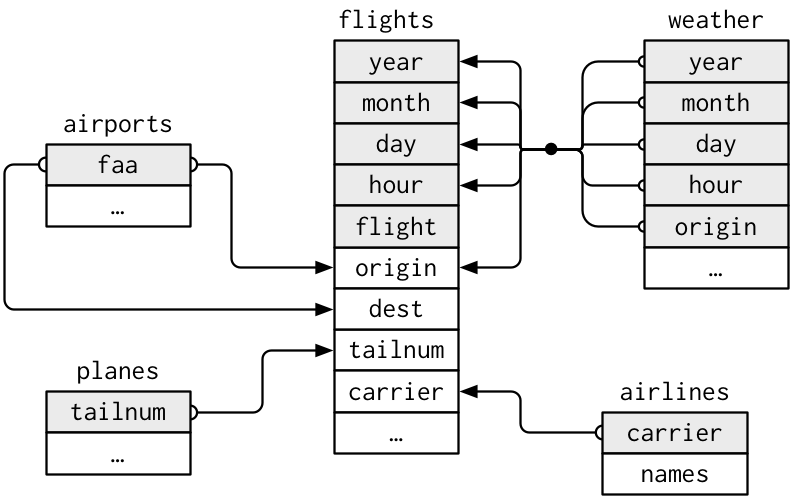
新しい列の追加: mutate()
既存の列名を指定すると上書き:
result = diamonds %>%
mutate(ratio = price / carat,
price = price * 108.36) %>%
print()
carat cut color clarity depth table price x y z ratio
<dbl> <ord> <ord> <ord> <dbl> <dbl> <dbl> <dbl> <dbl> <dbl> <dbl>
1 0.23 Ideal E SI2 61.5 55 35325.36 3.95 3.98 2.43 1417.391
2 0.21 Premium E SI1 59.8 61 35325.36 3.89 3.84 2.31 1552.381
3 0.23 Good E VS1 56.9 65 35433.72 4.05 4.07 2.31 1421.739
4 0.29 Premium I VS2 62.4 58 36192.24 4.20 4.23 2.63 1151.724
--
53937 0.72 Good D SI1 63.1 55 298748.52 5.69 5.75 3.61 3829.167
53938 0.70 Very Good D SI1 62.8 60 298748.52 5.66 5.68 3.56 3938.571
53939 0.86 Premium H SI2 61.0 58 298748.52 6.15 6.12 3.74 3205.814
53940 0.75 Ideal D SI2 62.2 55 298748.52 5.83 5.87 3.64 3676.000
tidyr — data.frameの変形・整形担当

- 横長から縦長に
pivot_longer()- 縦長から横長に
pivot_wider()- 入れ子構造をつくる、解消する
nest(),unnest()- 1列を複数の列に分離
separate()
etc.
tidyr::pivot_longer() 横長から縦長に
複数列にまたがる値を1列にする。
そのラベルも合わせて移動。
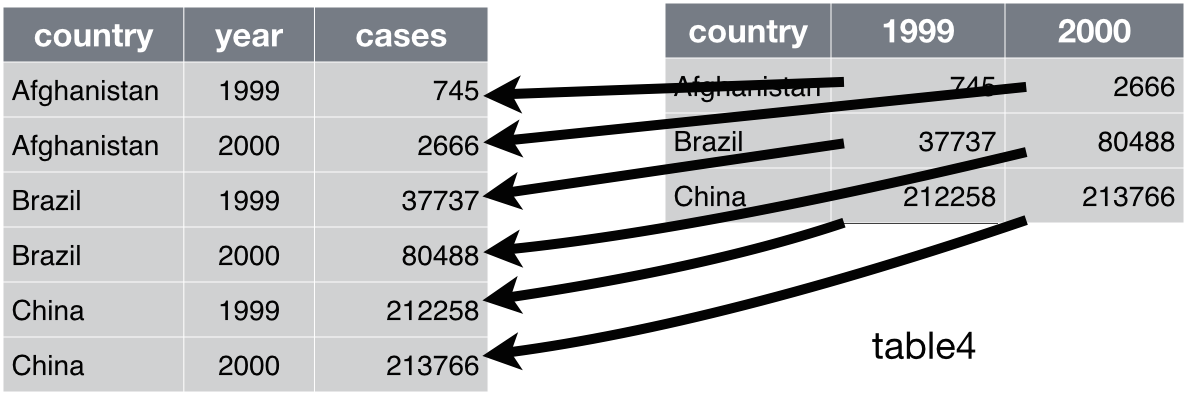
tidyr::pivot_longer() 横長から縦長に
複数列にまたがる値を1列にする(ここではvalue)。
そのラベルも合わせて移動(ここではname)。
iris_long = iris %>% head(2L) %>% # 最初の2行だけ
rownames_to_column("id") %>% # ID列を追加
print() %>% # 途中経過を表示
pivot_longer(c(-id, -Species), names_to = "name", values_to = "value") %>%
print() # id, Species以外の値を移動
id Sepal.Length Sepal.Width Petal.Length Petal.Width Species
<chr> <dbl> <dbl> <dbl> <dbl> <fct>
1 1 5.1 3.5 1.4 0.2 setosa
2 2 4.9 3.0 1.4 0.2 setosa
id Species name value
<chr> <fct> <chr> <dbl>
1 1 setosa Sepal.Length 5.1
2 1 setosa Sepal.Width 3.5
3 1 setosa Petal.Length 1.4
4 1 setosa Petal.Width 0.2
5 2 setosa Sepal.Length 4.9
6 2 setosa Sepal.Width 3.0
7 2 setosa Petal.Length 1.4
8 2 setosa Petal.Width 0.2
tidyr::pivot_wider() 縦長から横長に
1列に収まっていた値を複数列の行列に変換。
そのラベルを列の名前にする。
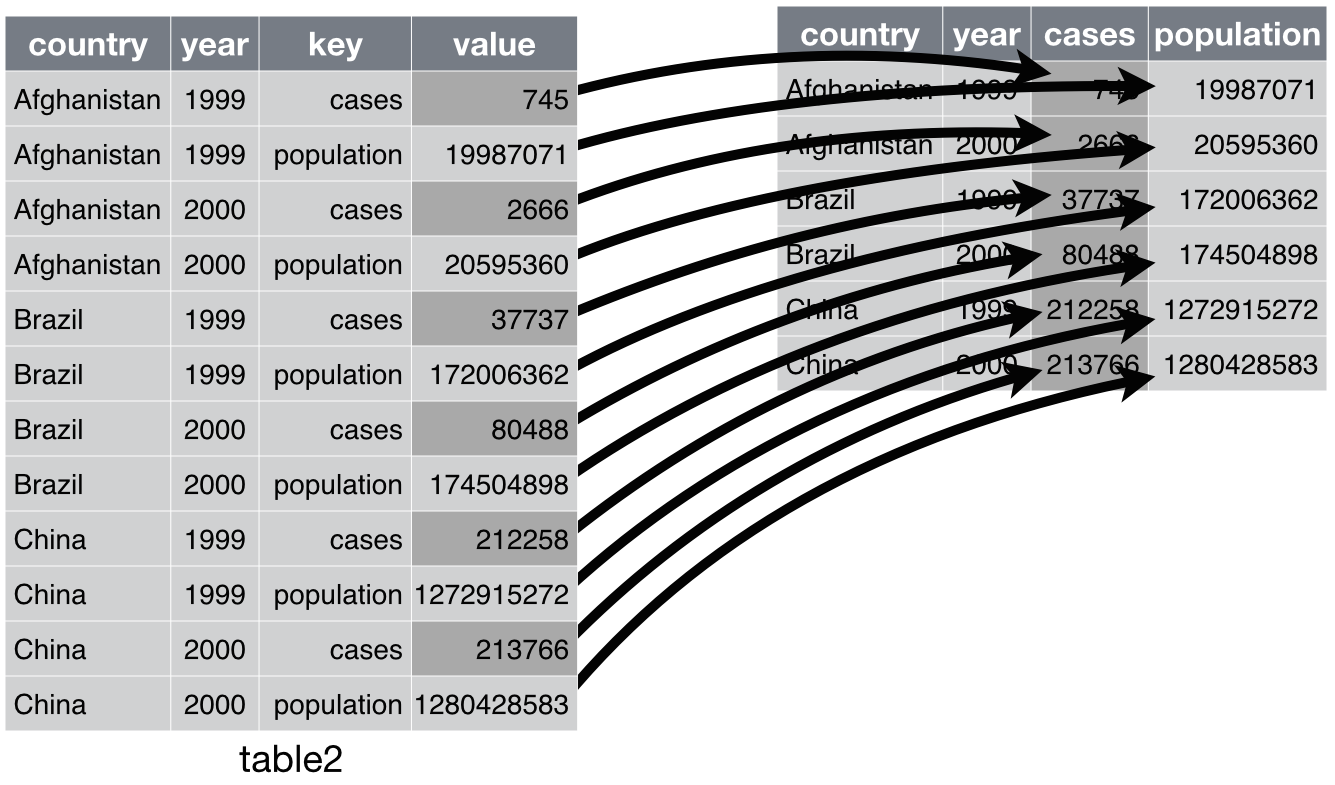
tidyr::pivot_wider() 縦長から横長に
1列に収まっていた値(value)を複数列の行列に変換。
そのラベル(name)を列の名前にする。
iris_long %>% print() %>% # さっきlong-formatにしたやつ
pivot_wider(names_from = name, values_from = value) # 横長に戻す
id Species name value
<chr> <fct> <chr> <dbl>
1 1 setosa Sepal.Length 5.1
2 1 setosa Sepal.Width 3.5
3 1 setosa Petal.Length 1.4
4 1 setosa Petal.Width 0.2
5 2 setosa Sepal.Length 4.9
6 2 setosa Sepal.Width 3.0
7 2 setosa Petal.Length 1.4
8 2 setosa Petal.Width 0.2
id Species Sepal.Length Sepal.Width Petal.Length Petal.Width
<chr> <fct> <dbl> <dbl> <dbl> <dbl>
1 1 setosa 5.1 3.5 1.4 0.2
2 2 setosa 4.9 3.0 1.4 0.2
tidyr::separate() 列を分離
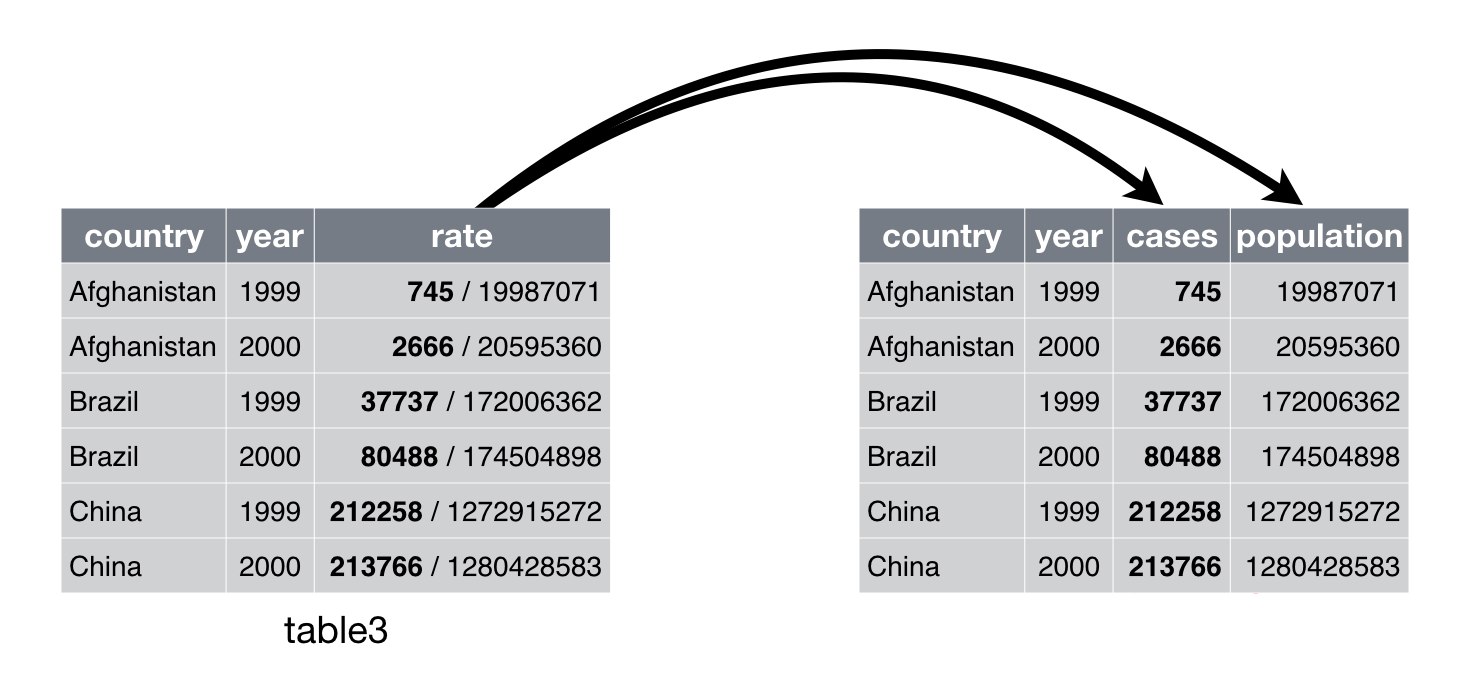
tidyr::separate() 列を分離
iris_long %>% print() %>%
separate(name, c("part", "measure")) # 列を分離
id Species name value
<chr> <fct> <chr> <dbl>
1 1 setosa Sepal.Length 5.1
2 1 setosa Sepal.Width 3.5
3 1 setosa Petal.Length 1.4
4 1 setosa Petal.Width 0.2
5 2 setosa Sepal.Length 4.9
6 2 setosa Sepal.Width 3.0
7 2 setosa Petal.Length 1.4
8 2 setosa Petal.Width 0.2
id Species part measure value
<chr> <fct> <chr> <chr> <dbl>
1 1 setosa Sepal Length 5.1
2 1 setosa Sepal Width 3.5
3 1 setosa Petal Length 1.4
4 1 setosa Petal Width 0.2
5 2 setosa Sepal Length 4.9
6 2 setosa Sepal Width 3.0
7 2 setosa Petal Length 1.4
8 2 setosa Petal Width 0.2
tidyr::unite() 列を融合
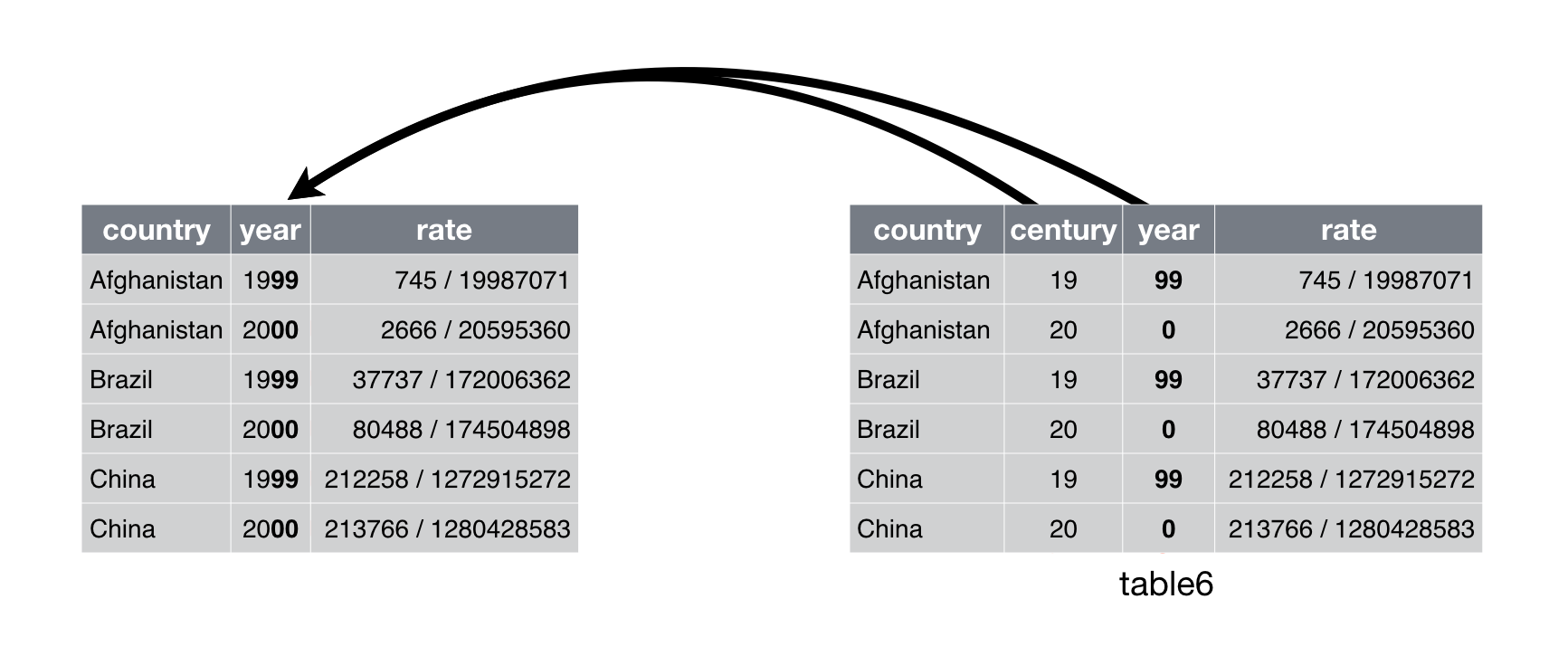
tidyr::nest() 入れ子にする
グループ毎にdata.frameを区切ってlist型の列に入れる。
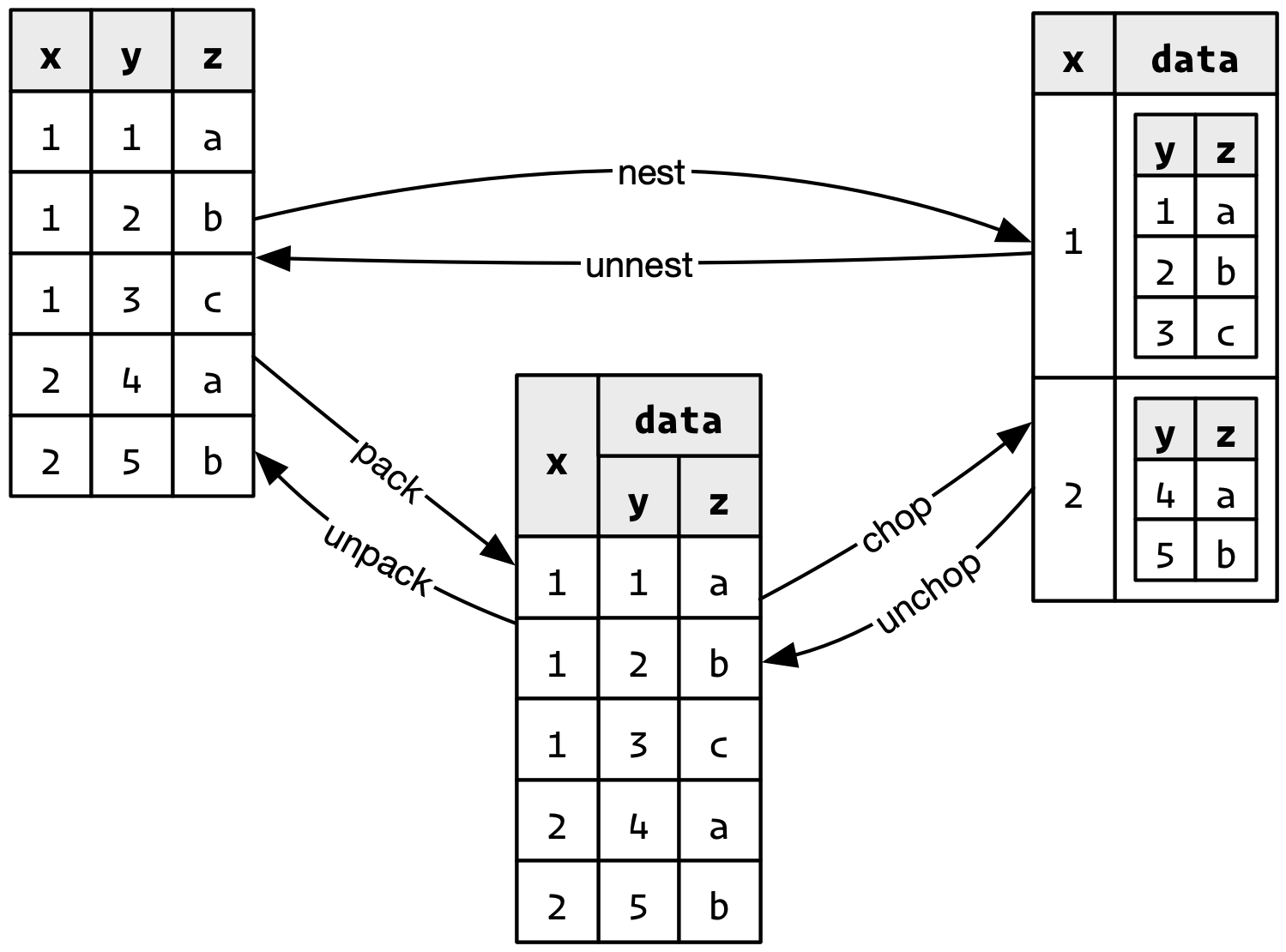
tidyr::nest() 入れ子にする
グループ毎にdata.frameを区切ってlist型の列に入れる。
iris_nested = iris %>%
as_tibble() %>%
nest(data = -Species) %>% print()
Species data
<fct> <list>
1 setosa <tbl_df [50 x 4]>
2 versicolor <tbl_df [50 x 4]>
3 virginica <tbl_df [50 x 4]>
iris_nested$data[[1L]]
Sepal.Length Sepal.Width Petal.Length Petal.Width
<dbl> <dbl> <dbl> <dbl>
1 5.1 3.5 1.4 0.2
2 4.9 3.0 1.4 0.2
3 4.7 3.2 1.3 0.2
4 4.6 3.1 1.5 0.2
--
47 5.1 3.8 1.6 0.2
48 4.6 3.2 1.4 0.2
49 5.3 3.7 1.5 0.2
50 5.0 3.3 1.4 0.2
例題1: VADeaths を縦長にしたい
as.data.frame(VADeaths) # data.frameに変換
# 行名を列に
# 縦長に変形したい
Rural Male Rural Female Urban Male Urban Female
50-54 11.7 8.7 15.4 8.4
55-59 18.1 11.7 24.3 13.6
60-64 26.9 20.3 37.0 19.3
65-69 41.0 30.9 54.6 35.1
70-74 66.0 54.3 71.1 50.0
例題1: VADeaths を縦長にしたい
as.data.frame(VADeaths) %>% # data.frameに変換
tibble::rownames_to_column("age") # 行名を列に
# 縦長に変形したい
age Rural Male Rural Female Urban Male Urban Female
1 50-54 11.7 8.7 15.4 8.4
2 55-59 18.1 11.7 24.3 13.6
3 60-64 26.9 20.3 37.0 19.3
4 65-69 41.0 30.9 54.6 35.1
5 70-74 66.0 54.3 71.1 50.0
例題1: VADeaths を縦長にしたい
as.data.frame(VADeaths) %>% # data.frameに変換
tibble::rownames_to_column("age") %>% # 行名を列に
pivot_longer(-age) # age以外を移動して縦長化
# 新しいname列を分割
age name value
<chr> <chr> <dbl>
1 50-54 Rural Male 11.7
2 50-54 Rural Female 8.7
3 50-54 Urban Male 15.4
4 50-54 Urban Female 8.4
--
17 70-74 Rural Male 66.0
18 70-74 Rural Female 54.3
19 70-74 Urban Male 71.1
20 70-74 Urban Female 50.0
例題1: VADeaths を縦長にしたい
as.data.frame(VADeaths) %>% # data.frameに変換
tibble::rownames_to_column("age") %>% # 行名を列に
pivot_longer(-age) %>% # age以外を移動して縦長化
separate(name, c("region", "sex")) # 新しいname列を分割
age region sex value
<chr> <chr> <chr> <dbl>
1 50-54 Rural Male 11.7
2 50-54 Rural Female 8.7
3 50-54 Urban Male 15.4
4 50-54 Urban Female 8.4
--
17 70-74 Rural Male 66.0
18 70-74 Rural Female 54.3
19 70-74 Urban Male 71.1
20 70-74 Urban Female 50.0
例題1: VADeaths を縦長にしたい
va_deaths = as.data.frame(VADeaths) %>% # data.frameに変換
tibble::rownames_to_column("age") %>% # 行名を列に
pivot_longer(-age) %>% # age以外を移動して縦長化
separate(name, c("region", "sex")) %>% # 新しいname列を分割
separate(age, c("lbound", "ubound"), "-", convert = TRUE) %>%
print() # 下限と上限を分離
lbound ubound region sex value
<int> <int> <chr> <chr> <dbl>
1 50 54 Rural Male 11.7
2 50 54 Rural Female 8.7
3 50 54 Urban Male 15.4
4 50 54 Urban Female 8.4
--
17 70 74 Rural Male 66.0
18 70 74 Rural Female 54.3
19 70 74 Urban Male 71.1
20 70 74 Urban Female 50.0
例題1: VADeaths 別解
va_deaths = as.data.frame(VADeaths) %>% # data.frameに変換
tibble::rownames_to_column("age") %>% # 行名を列に
tidyr::pivot_longer( # 縦長に変形したい
-age, # age以外の列に入ってる値を移動
names_to = c("region", "sex"), # 元の列名を2つに分離
names_sep = " ", # スペースで切る
values_to = "death") %>% # 値の行き先の列名
tidyr::separate(age, c("lbound", "ubound"), "-", convert = TRUE) %>%
print() # 下限と上限を分離
lbound ubound region sex death
<int> <int> <chr> <chr> <dbl>
1 50 54 Rural Male 11.7
2 50 54 Rural Female 8.7
3 50 54 Urban Male 15.4
4 50 54 Urban Female 8.4
--
17 70 74 Rural Male 66.0
18 70 74 Rural Female 54.3
19 70 74 Urban Male 71.1
20 70 74 Urban Female 50.0
例題1: VADeaths 作図例
va_deaths %>%
ggplot(aes(lbound, death)) +
geom_point(aes(color = sex, shape = region), size = 5) +
theme_classic(base_size = 16)
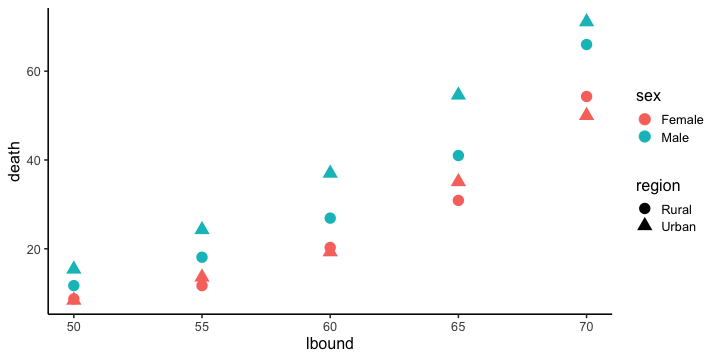
例題2: anscombe
4組のx-yは、平均・分散・相関係数がほぼ同じ?
anscombe %>%
rowid_to_column("id") # IDをつけておく
# x y で始まる列の値を移して縦長に
id x1 x2 x3 x4 y1 y2 y3 y4
<int> <dbl> <dbl> <dbl> <dbl> <dbl> <dbl> <dbl> <dbl>
1 1 10 10 10 8 8.04 9.14 7.46 6.58
2 2 8 8 8 8 6.95 8.14 6.77 5.76
3 3 13 13 13 8 7.58 8.74 12.74 7.71
4 4 9 9 9 8 8.81 8.77 7.11 8.84
--
8 8 4 4 4 19 4.26 3.10 5.39 12.50
9 9 12 12 12 8 10.84 9.13 8.15 5.56
10 10 7 7 7 8 4.82 7.26 6.42 7.91
11 11 5 5 5 8 5.68 4.74 5.73 6.89
ggplot does not accept this format. Let’s transformt it.
例題2: anscombe
4組のx-yは、平均・分散・相関係数がほぼ同じ?
anscombe %>%
rowid_to_column("id") %>% # IDをつけておく
pivot_longer(matches("^x|y")) # x y で始まる列の値を移して縦長に
# name列を分割
id name value
<int> <chr> <dbl>
1 1 x1 10.00
2 1 x2 10.00
3 1 x3 10.00
4 1 x4 8.00
--
85 11 y1 5.68
86 11 y2 4.74
87 11 y3 5.73
88 11 y4 6.89
例題2: anscombe
4組のx-yは、平均・分散・相関係数がほぼ同じ?
anscombe %>%
rowid_to_column("id") %>% # IDをつけておく
pivot_longer(matches("^x|y")) %>% # x y で始まる列の値を移して縦長に
separate(name, c("axis", "group"), 1L, convert = TRUE)
# name列を分割
id axis group value
<int> <chr> <int> <dbl>
1 1 x 1 10.00
2 1 x 2 10.00
3 1 x 3 10.00
4 1 x 4 8.00
--
85 11 y 1 5.68
86 11 y 2 4.74
87 11 y 3 5.73
88 11 y 4 6.89
例題2: anscombe
4組のx-yは、平均・分散・相関係数がほぼ同じ?
tidy_anscombe = anscombe %>%
rowid_to_column("id") %>% # IDをつけておく
pivot_longer(matches("^x|y")) %>% # x y で始まる列の値を移して縦長に
separate(name, c("axis", "group"), 1L, convert = TRUE) %>%
# name列を分割
pivot_wider(names_from = axis, values_from = value) %>%
# axis列内の x y を列にして横長化
dplyr::arrange(group) %>% # グループごとに並べる
print() # ggplotしたい形!
id group x y
<int> <int> <dbl> <dbl>
1 1 1 10 8.04
2 2 1 8 6.95
3 3 1 13 7.58
4 4 1 9 8.81
--
41 8 4 19 12.50
42 9 4 8 5.56
43 10 4 8 7.91
44 11 4 8 6.89
例題2: anscombe 別解
4組のx-yは、平均・分散・相関係数がほぼ同じ?
tidy_anscombe = anscombe %>%
tidyr::pivot_longer( # 縦長に変形したい
everything(), # すべての列について
names_to = c(".value", "group"), # 新しい列名
names_sep = 1L) %>% # 切る位置
dplyr::mutate(group = as.integer(group)) %>% # 型変換
dplyr::arrange(group) %>% # グループごとに並べる
print() # ggplotしたい形!
group x y
<int> <dbl> <dbl>
1 1 10 8.04
2 1 8 6.95
3 1 13 7.58
4 1 9 8.81
--
41 4 19 12.50
42 4 8 5.56
43 4 8 7.91
44 4 8 6.89
例題2: anscombe 作図例
4組のx-yは、平均・分散・相関係数がほぼ同じ?
ggplot(tidy_anscombe, aes(x, y)) +
geom_point(size = 3) +
stat_smooth(method = lm, formula = y ~ x, se = FALSE, fullrange = TRUE) +
facet_wrap(~ group, nrow = 1L)

例題2: anscombe 要約
4組のx-yは、平均・分散・相関係数がほぼ同じ?
tidy_anscombe %>%
dplyr::group_by(group) %>% # group列でグループ化して
dplyr::summarize( # x, y列を使ってsummarize
mean_x = mean(x),
mean_y = mean(y),
sd_x = sd(x),
sd_y = sd(y),
cor_xy = cor(x, y)
)
group mean_x mean_y sd_x sd_y cor_xy
<int> <dbl> <dbl> <dbl> <dbl> <dbl>
1 1 9 7.500909 3.316625 2.031568 0.8164205
2 2 9 7.500909 3.316625 2.031657 0.8162365
3 3 9 7.500000 3.316625 2.030424 0.8162867
4 4 9 7.500909 3.316625 2.030579 0.8165214
Reference
- R for Data Science — Hadley Wickham & Garrett Grolemund
- Website, Book
- 日本語版書籍(Rではじめるデータサイエンス)
RユーザのためのRStudio[実践]入門 — 松村優哉ほか
前処理大全 — 本橋智光
- 過去の講義資料
- 「Rにやらせて楽しよう — データの可視化と下ごしらえ」 岩嵜航 2018
- 「Rを用いたデータ解析の基礎と応用」石川由希 2019 名古屋大学
- 「Hands-on R Lecture for Makino Lab」 岩嵜航 2019 東北大学
- Official documents:
- tidyverse, ggplot2, dplyr, tidyr, purrr, tibble, readr, readxl